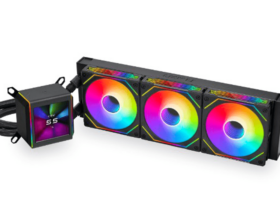Noctua NH-P1 review. A heat sink that loves to dare, with a Fanless design. Will a fanless cooler do the job? Let’s find out
The Austrian house Noctua, introduces its new heatsink onto the market Fanless NH-P1. A very impressive heatsink, from quite important lamellar body, which is positioned in a particular market segment. Let’s face it, these heatsinks are certainly not the first ones a build build user clearly aspires to. They are heatsinks that are aimed at a specific and well-selected audience, which needs a completely passive system for reasons of silence, or because you simply have to create a PC that works a long time but with fairly simple operations to manage.
Noctua NH-P1 weighs one 1.180 Kg, and has a generous size of 158 mm x 154 mm x 152 mm (Height x Width x Depth) with no fan installed. Let’s find out how this cooler behaved during the tests.
Design and features | Noctua NH-P1 review
Of this Noctua heatsink, the first thing that catches the eye are obviously the dimensions, which are really important. The design is simple, we have no particular elements except the lamellar body has been designed to obtain the maximum performance thanks to a particular angled shape. The lamellae are strategically spaced, and traversed by 6 Heat Pipe.
The heatsink has generous dimensions to support jobs for a long time, but if you want you can mount an optional fan in the upper part of the reed body. The fins are thick and spaced just to cope with Fanless uses.
Noctua on its website provides a section where you can check compatibility with your components, such as some motherboards. At the following link find the Noctua Compatibility Centre. The reason is simple, many current motherboards have the slot PCIe x16 superiore close to the socket, due to its asymmetrical layout, its baseplate is offset towards the top edge of the motherboard and could cause mounting problems. Do not worry instead with the RAM, precisely because of the asymmetry Noctua ensures that with up to a height of 45 mm you will not have any problems. In our case, with our case, we could not literally close the bulkhead with the fan installed.

The mounting system is the consolidated one Noctua SecuFirm2, which provides, after installing the backplate compatible with your configuration, to screw the heatsink with an Allen key without touching the reed valve thanks to its contained profile. And it boasts support for Intel platforms LGA1200, LGA115x (LGA1150, LGA1151, LGA1155, LGA1156) and LGA20xx (LGA2066, LGA2011-0, LGA2011-3), and AMD AM4, AM3 (+), AM2 (+), FM2 (+ ) and FM1.
The problem arises when we try to insert the clips to fix the fan, which are not perfectly stable, and makes the process difficult. Especially the hooks that must be placed at the base of the backplate, while the risk during assembly is to bend the lamellar body, so care must be taken in this regard. Comes with NT-H2 thermal paste, a solution that offers a Thermal Conductivity level of approx 9 W, quite good. In the end, 6 years insured warranty.
Test and Benchmark Build | Noctua NH-P1 review
Noctua does not make high claims, but basically because this is a product that caters to a specific audience. And, for the avoidance of doubt, she herself publishes a note on the product page, including the following words;
Warning: While the NH-P1 provides top-notch performance compatibly for a typical passive cooler, it is not suitable for overclocking or CPUs that generate high amounts of heat.
Please note that the TDP (Thermal Design Power) o amount of heat dissipation that the heatsink can handle is not dependent on the heatsink itself and is affected by various factors such as ambient temperature, case, or other components within the system, but generally also varies by CPU model. For this reason, we specify the cooling performance using the Noctua Standardised Performance Rating (NSPR) instead of giving a specific general TDP. Please also note that the NH-P1 strictly requires either a well-dissipated case, a test bench configuration with fans in order to achieve its maximum performance.
Our configuration;
- Motherboard: Asus TUF Gaming B550 Plus
- CPU: AMD Ryzen 7 3700X
- Case: Kolink Void X
- Ram: 32 GB Corsair Vengeance RGB PRO
- Form Video: RTX 2080 MSI Ventus
- Heatsink: //
Let’s first see the tests carried out in fanless mode and then with the fan installed, and then recover in the final considerations.
Tests carried out in Fanless mode
Tests carried out with fan installed
We did not purposely test in Game, as we felt that everything would be unsuitable for the nature of the product. As you can see the performances themselves are not terrible, indeed, for being such a particular product we consider them acceptable. Obviously, it is not a very comfortable heat sink, from the point of view of size and, especially for those who, with the PC, perform heavy work every day, but Noctua has however produced something really interesting and singular. A good show of strength.
Noctua has even created a page dedicated to the compatibility list of what, in her opinion, are the best houses in which to install this heatsink (here the link to the page Recommended Cases for NH-P1 | Noctua Compatibility Center), and a section dedicated to compatible CPUs in terms of dissipative capacity with the NH-P1 (link to the page relating to NH-P1 compatible CPUs | Cooler Compatibility | Noctua Compatibility Centre). We really appreciate this maniacal attention from the brand, which is a clear sign of professionalism and fairness towards the consumer.
Conclusions and price
For a price of 109 Euros, in short, it is a heatsink that it is certainly not suitable for a content creator audience doing heavy and long editing jobs, or to a streamer / gamer audience.
You certainly won’t have first-class performance, but that’s certainly not the audience that Noctua aspires to with this product. The Austrian house tries with this NH-P1 to satisfy customers looking to make super quiet machines, but that at the same time I do not carry out particular heavy work, and do not use processors with many cores and therefore very energy-consuming in terms of energy. Noctua does not indicate the maximum supported wattage target, but it is certainly not high. For these specific users, however, it is certainly an interesting product, just pay attention to the size before purchasing. For the review of the Noctua NH-P1 that’s all, to stay updated on the hardware world, keep following our pages.
An ambitious sink!
Points in favor
- Assembly kit complete with torx screwdriver
- Quality of materials
- Performance
Points against
- Price
- Mounting system















Leave a Reply
View Comments